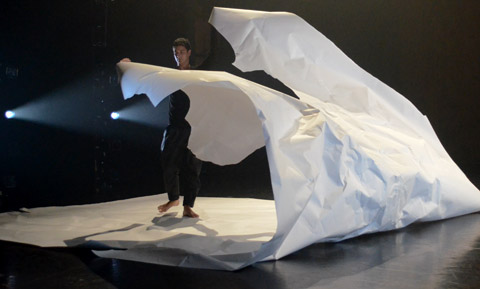
MISBEHAVING In Bokaer’s pieces, dancers often try to manipulate an environment that has a mind
of its own. |
Jonah Bokaer's two new works, shown last weekend at Jacob's Pillow, seemed at first childishly simple. Both began with a man making his way across a space that was gradually changing and only partly predictable. Bokaer didn't provide any grandiose program notes or play up the profound implications in his dances, but by the end of the performance we'd seen small transformations and beautiful visions, and even confronted big questions about control and randomness, civilization and nature.In Recess, Bokaer unrolled a big tube of photographers' paper on the floor with one pointed foot, then carefully folded it into a triangle and marked its geometry with a circuit of flat moves. In the same deliberate but mysterious way he crumpled the white carpet around his whole body, turning it into a huge iceberg. When he walked away it began to move of its own accord. Lying on the floor he folded and unfolded his limbs; the iceberg seemed to be shadowing him. He made a new, bunchy shape with more of the paper; it became a creeping glacier.
Bokaer somersaulted on the carpet, he tore it and folded it, measuring, calculating. Still it misbehaved. After he used up all of the roll, he left and came back with a missing piece: an approximately human cutout shape. He wrapped his legs in it, slid the cylinder off, and stood a little paper man on the floor. He and the inanimate forms seemed to have been exchanging identities.
For Why Patterns, a big square was laid out in the space with thin plastic tubes. The dancers — CC Chang, James McGinn, Irena Misirlic, and Adam H. Weinert — once again manipulated an environment that had ideas of its own. As the first man paced backwards into the space, a ping pong ball fell from a hidden source high in the wings. The man blew it from one corner to the other, crawling on his hands and feet.
Balls kept falling in at regular intervals, and the other three dancers entered, pacing at different speeds and in different directions among the accumulating drift. After a sudden shower of hundreds of balls, the dancers began a series of invented ping-pong-ball games. The plastic tubes bordering the space became implements in the games. More ping pong balls fell out of the tubes when they were tilted.
All this action was low-key. At times it evoked other kinds of equipment-driven activity, like the strength and agility tests of Elizabeth Streb, but everything was diminished, even the playfulness. After a while, one of the dancers began pushing one of the bordering tubes along one side of the space, clearing a temporary corridor. Someone, maybe the same person, began throwing as many balls as she could out of the arena, but the fallout continued.
All four dancers stood in a corner at one point, looking to the right as if anticipating something. With a rush, a great stream of balls shot out of the wing, like water let out of a dam. A torrent with no letup.